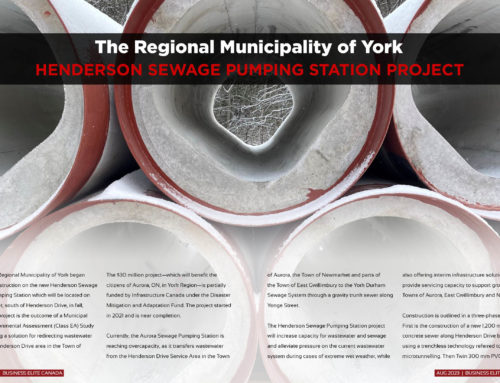Home to sunshine, industry and growth
By Rajitha Sivakumaran
No municipality demonstrates the importance of location better than Leamington, an urban centre that sits along the most southern edge of Ontario, overlooking Lake Erie. Being located in the vicinity of Point Pelee National Park doesn’t just bring in much sought after migrating monarch butterflies or birdwatchers from all over the world. In fact, for a municipality bountiful in nature, Leamington is quite industrious.
This economic drive is fuelled by a zealous thirst for growth and prosperity, but the municipality doesn’t need to look beyond its borders for these drivers; it already boasts a strong footing in a number of industries, a few which are not present to such a great extent elsewhere in Canada.
Although things have remained somewhat stagnant in Windsor-Essex County, the larger area to which Leamington belongs, Mayor John Paterson professed that his municipality is growing and that may be attributable to Leamington’s best-kept secret — the fact that the municipality sits on the 42nd parallel, the result of which is a wonderful growing season that allows for a bountiful supply of all that comes out of the ground.
Leamington has the largest concentration of commercial greenhouses in North America, rivaling Europe, California and Mexico. The industry is experiencing an incredible acceleration of growth right now, growing at roughly five per cent per year, a combination of sales and land mass. The mayor attributes the spur of entrepreneurship in Leamington to the greenhouse sector, a sector that is always looking for innovative ways of conducting business. “It’s just tremendous, some of the inventions and ideas that have come out of this area,” Mayor Paterson said. To meet the demands of the agribusiness sector is the manufacturing industry, Leamington’s second largest economic driver. Accordingly, Leamington was named one of the top 10 entrepreneurial spots in Canada by Forbes Magazine last year.
One of the unique things about Leamington is that despite being an urban community in a very rural landscape, it is home to a hospital that specializes in acute care, making health care and social services the third largest sector in the municipality. Presently, the hospital is diversifying its service portfolio to fill the gaps in specialties.
“One thing that we discovered here locally, and this is why health care is a large sector and an exciting sector, is that the innovation that exists inside of health care can provide a revenue stream in order to take care of the gaps that exist in funding as opposed to fundraising all the time,” said Jeanine Lassaline-Berglund, the municipality’s economic development officer.
The fourth largest sector is tourism, followed by small businesses and entrepreneurships, which serve as the backbone of this community. A few large enterprises, like Highbury Canco and Highland Mushrooms, in addition to numerous large corporate greenhouses and manufacturing companies, help stabilize this backbone by hiring locals.
“It’s not about going after large investments. For us, our stability and growth is going to come from what’s already here,” Lassaline-Berglund said, stating that roughly 70 per cent of the community’s growth will come from successful businesses that are already established in Leamington.
Even though Leamington is home to large corporate entities, it houses many community-minded entrepreneurs, which is why Leamington is an ideal place to start a business. Leamington’s business owners are very much available to the community, whether it be to offer feedback to startups or assess the feasibility of a new business. It also helps that property prices, whether it be commercial, industrial or residential, are quite inexpensive compared to city locations.
Up until now, the municipality has let tourism take its own course and visitors came voluntarily, drawn by the area’s beauty. The national park, for instance, draws 240,000 visitors per year. Referred to as the Sun Parlour of Canada, the municipality enjoys year-round ecotourism. “People who are interested in ecotourism or in an active lifestyle can really be outside a great portion of the year,” Lassaline-Berglund said.
Like many towns in Ontario, Leamington looked to regional partners to market the municipality. There was no specific person or entity driving the tourism industry to its full potential, but this is where the municipality is now going to be playing a big role. Mayor Paterson and his team are working on making Leamington a year-round destination spot for tourists.
#somethingshappening
Leamington sported the name ‘the tomato capital of Canada’ for a long time, but when the H. J. Heinz Company of Canada closed its plant in 2013 after being operational for over 100 years, countless people lost their livelihoods. Since Heinz was the municipality’s largest employer at the time, the departure was quite a blow to the community, but low spirits did not last for too long. “There were a lot of hours spent here with various agencies trying to figure out where to go from here,” said Mayor Paterson and within a month or two, the municipality started carving out Leamington’s future. “Council made several business decisions to move the municipality forward… we still refer to ourselves as the Tomato Capital of Canada, but we are looking at other branding strategies for the future.”
“Even though we’re known for tomatoes, the volume of other products that come out of this region might be startling to the average person so we’re paying more attention to how we could market beyond the tomato,” Lassaline-Berglund added.
Since Heinz’s departure, the focus has been on forming partnerships. Leamington recently partnered with the Caldwell First Nation, whereby band members can develop the skills needed for governance in their own communities through internship programs with Leamington’s governing body. “I think a lot of communities have had a less-than-welcoming relationship with First Nations communities,” Mayor Paterson said, but Leamington doesn’t fall into this category. When the Caldwell First Nation announced that they were coming to Leamington, the first thing Mayor Paterson did was reach out to its chief, Louise Hillier. “It’s been a great relationship since then,” the mayor added.
Leamington, unlike other communities in Ontario, has the most cultural diversity per capita. It is home to temporary foreign workers and seasonal agricultural workers who keep the agribusiness thriving. At any given time, almost a third of the population is constituted by migrant workers and these people make a full-time impact on the community. “It’s unfortunate that we have not recognized this until now, but you will see a lot of community development initiatives rise out of that as a result,” Lassaline-Berglund said.
Another challenge lies with past economic decisions that marketed Leamington as an ideal retirement spot. This move has influenced population demographics in a less than positive way since many of the residents in Leamington are elderly. The present concern is the expected decrease in population, but the municipality is combatting this through a youth engagement strategy, which exposes young local people to opportunities that exists in the municipality.
One of the trends Mayor Paterson has noted in the manufacturing sector is an insufficiency of skilled workers. To fill this gap, the municipality plans to draw new residents with specialized skill sets, which will effectively stabilize the population as well. Leamington was the only small community in Ontario to privately sponsor 12 Syrian families in response to the civil war in Syria.
“It’s easy being mayor because everything is going in the right direction now,” Mayor Paterson said.
www.leamington.ca






